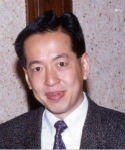
Prof. Chumin Wang
National Autonomous University, Mexico
Title: Renormalization approach to the thermoelectric transport in poly(G)-poly(C) double chains
Abstract:
Molecular electronics inspired by nature are of great interest, due to its unique quantum behavior even at room temperature and its ability to form macroscopic length structures by self-assembly. In particular, self-assembled deoxyribonucleic acid (DNA) molecules, made by either cytosine-guanine (CG) or adenine-thymine (AT) stacked pairs coupled via hydrogen bonds and attached to the double-helix structure through sugar-phosphate backbones, may behave as low-dimensional conductors, semiconductors or insulators, since their electrical conductivity has a strong dependence on the system length and base-pair sequences. Ab-initio and semi-empirical studies of DNA molecules have been performed and among them, the latter has the advantage of being simple and suitable for a macroscopic scale structural ordering analysis of the charge transport.
In this talk, we present a quantum mechanical study of the electronic and phononic transport in DNA systems with macroscopic length by means of a real-space renormalization method [1] within the Boltzmann formalism, where the poly(G)-poly(C) base-pair segments arranged following periodic and Fibonacci sequences are comparatively analyzed. The fishbone model and the two-site coarse grain model based on the Born potential including central and non-central interactions are respectively used for the calculation of electrical and lattice thermal conductivities of these DNA systems connected to two reservoirs at their ends [2]. The results show the appearance of gaps in phononic transmittance spectra of segmented poly(G)-poly(C) double chains, which leads to a better thermoelectric figure of merit (ZT) than that of corresponding non-segmented systems. Such ZT can be further improved by introducing a long-range quasiperiodic order, which avoids the thermal transport of numerous low-frequency phonons responsible of the lattice thermal conduction at low temperature. Finally, the influence of reservoirs on ZT is also investigated [3].
This work has been partially supported by CONACyT-252943 and UNAM-IN110020. Computations were carried out at Miztli of DGTIC, UNAM.
[1] C. Wang, F. Salazar and V. Sanchez, Nano Lett. 8, 4205 (2008).
[2] J. E. Gonzalez, V. Sanchez and C. Wang, MRS Communications 8, 248 (2018).
[3] J. E. Gonzalez, M. Cruz-Irisson, V. Sanchez and C. Wang, J. Phys. Chem. Solids 136, 109136 (2020).
Biography:
Chumin Wang received the B.S., M.S., and Ph.D. degrees in physics from the National Autonomous University of Mexico (UNAM). He was a Postdoctoral Associate at the Department of Physics, University of California at Berkeley, from 1993 to 1994. He is currently a tenured full professor and researcher at the Materials Research Institute, UNAM. His research interests include strongly correlated electron systems and elementary excitations in quasicrystals as well as in porous semiconductors.